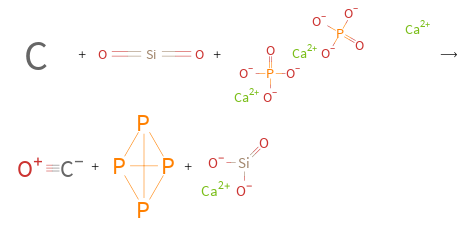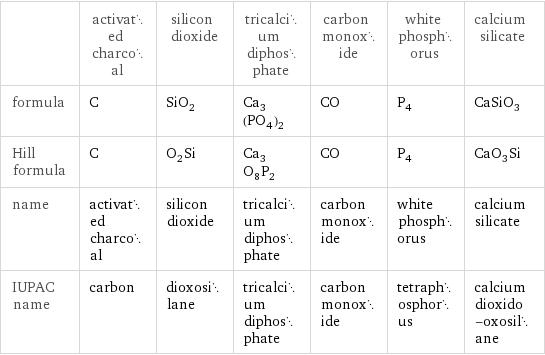Input interpretation

C (activated charcoal) + SiO_2 (silicon dioxide) + Ca_3(PO_4)_2 (tricalcium diphosphate) ⟶ CO (carbon monoxide) + P_4 (white phosphorus) + CaSiO_3 (calcium silicate)
Balanced equation

Balance the chemical equation algebraically: C + SiO_2 + Ca_3(PO_4)_2 ⟶ CO + P_4 + CaSiO_3 Add stoichiometric coefficients, c_i, to the reactants and products: c_1 C + c_2 SiO_2 + c_3 Ca_3(PO_4)_2 ⟶ c_4 CO + c_5 P_4 + c_6 CaSiO_3 Set the number of atoms in the reactants equal to the number of atoms in the products for C, O, Si, Ca and P: C: | c_1 = c_4 O: | 2 c_2 + 8 c_3 = c_4 + 3 c_6 Si: | c_2 = c_6 Ca: | 3 c_3 = c_6 P: | 2 c_3 = 4 c_5 Since the coefficients are relative quantities and underdetermined, choose a coefficient to set arbitrarily. To keep the coefficients small, the arbitrary value is ordinarily one. For instance, set c_5 = 1 and solve the system of equations for the remaining coefficients: c_1 = 10 c_2 = 6 c_3 = 2 c_4 = 10 c_5 = 1 c_6 = 6 Substitute the coefficients into the chemical reaction to obtain the balanced equation: Answer: | | 10 C + 6 SiO_2 + 2 Ca_3(PO_4)_2 ⟶ 10 CO + P_4 + 6 CaSiO_3
Structures

+ + ⟶ + +
Names

activated charcoal + silicon dioxide + tricalcium diphosphate ⟶ carbon monoxide + white phosphorus + calcium silicate
Equilibrium constant
![Construct the equilibrium constant, K, expression for: C + SiO_2 + Ca_3(PO_4)_2 ⟶ CO + P_4 + CaSiO_3 Plan: • Balance the chemical equation. • Determine the stoichiometric numbers. • Assemble the activity expression for each chemical species. • Use the activity expressions to build the equilibrium constant expression. Write the balanced chemical equation: 10 C + 6 SiO_2 + 2 Ca_3(PO_4)_2 ⟶ 10 CO + P_4 + 6 CaSiO_3 Assign stoichiometric numbers, ν_i, using the stoichiometric coefficients, c_i, from the balanced chemical equation in the following manner: ν_i = -c_i for reactants and ν_i = c_i for products: chemical species | c_i | ν_i C | 10 | -10 SiO_2 | 6 | -6 Ca_3(PO_4)_2 | 2 | -2 CO | 10 | 10 P_4 | 1 | 1 CaSiO_3 | 6 | 6 Assemble the activity expressions accounting for the state of matter and ν_i: chemical species | c_i | ν_i | activity expression C | 10 | -10 | ([C])^(-10) SiO_2 | 6 | -6 | ([SiO2])^(-6) Ca_3(PO_4)_2 | 2 | -2 | ([Ca3(PO4)2])^(-2) CO | 10 | 10 | ([CO])^10 P_4 | 1 | 1 | [P4] CaSiO_3 | 6 | 6 | ([CaSiO3])^6 The equilibrium constant symbol in the concentration basis is: K_c Mulitply the activity expressions to arrive at the K_c expression: Answer: | | K_c = ([C])^(-10) ([SiO2])^(-6) ([Ca3(PO4)2])^(-2) ([CO])^10 [P4] ([CaSiO3])^6 = (([CO])^10 [P4] ([CaSiO3])^6)/(([C])^10 ([SiO2])^6 ([Ca3(PO4)2])^2)](../image_source/86fa952449d0ce824aa26c28449c367b.png)
Construct the equilibrium constant, K, expression for: C + SiO_2 + Ca_3(PO_4)_2 ⟶ CO + P_4 + CaSiO_3 Plan: • Balance the chemical equation. • Determine the stoichiometric numbers. • Assemble the activity expression for each chemical species. • Use the activity expressions to build the equilibrium constant expression. Write the balanced chemical equation: 10 C + 6 SiO_2 + 2 Ca_3(PO_4)_2 ⟶ 10 CO + P_4 + 6 CaSiO_3 Assign stoichiometric numbers, ν_i, using the stoichiometric coefficients, c_i, from the balanced chemical equation in the following manner: ν_i = -c_i for reactants and ν_i = c_i for products: chemical species | c_i | ν_i C | 10 | -10 SiO_2 | 6 | -6 Ca_3(PO_4)_2 | 2 | -2 CO | 10 | 10 P_4 | 1 | 1 CaSiO_3 | 6 | 6 Assemble the activity expressions accounting for the state of matter and ν_i: chemical species | c_i | ν_i | activity expression C | 10 | -10 | ([C])^(-10) SiO_2 | 6 | -6 | ([SiO2])^(-6) Ca_3(PO_4)_2 | 2 | -2 | ([Ca3(PO4)2])^(-2) CO | 10 | 10 | ([CO])^10 P_4 | 1 | 1 | [P4] CaSiO_3 | 6 | 6 | ([CaSiO3])^6 The equilibrium constant symbol in the concentration basis is: K_c Mulitply the activity expressions to arrive at the K_c expression: Answer: | | K_c = ([C])^(-10) ([SiO2])^(-6) ([Ca3(PO4)2])^(-2) ([CO])^10 [P4] ([CaSiO3])^6 = (([CO])^10 [P4] ([CaSiO3])^6)/(([C])^10 ([SiO2])^6 ([Ca3(PO4)2])^2)
Rate of reaction
![Construct the rate of reaction expression for: C + SiO_2 + Ca_3(PO_4)_2 ⟶ CO + P_4 + CaSiO_3 Plan: • Balance the chemical equation. • Determine the stoichiometric numbers. • Assemble the rate term for each chemical species. • Write the rate of reaction expression. Write the balanced chemical equation: 10 C + 6 SiO_2 + 2 Ca_3(PO_4)_2 ⟶ 10 CO + P_4 + 6 CaSiO_3 Assign stoichiometric numbers, ν_i, using the stoichiometric coefficients, c_i, from the balanced chemical equation in the following manner: ν_i = -c_i for reactants and ν_i = c_i for products: chemical species | c_i | ν_i C | 10 | -10 SiO_2 | 6 | -6 Ca_3(PO_4)_2 | 2 | -2 CO | 10 | 10 P_4 | 1 | 1 CaSiO_3 | 6 | 6 The rate term for each chemical species, B_i, is 1/ν_i(Δ[B_i])/(Δt) where [B_i] is the amount concentration and t is time: chemical species | c_i | ν_i | rate term C | 10 | -10 | -1/10 (Δ[C])/(Δt) SiO_2 | 6 | -6 | -1/6 (Δ[SiO2])/(Δt) Ca_3(PO_4)_2 | 2 | -2 | -1/2 (Δ[Ca3(PO4)2])/(Δt) CO | 10 | 10 | 1/10 (Δ[CO])/(Δt) P_4 | 1 | 1 | (Δ[P4])/(Δt) CaSiO_3 | 6 | 6 | 1/6 (Δ[CaSiO3])/(Δt) (for infinitesimal rate of change, replace Δ with d) Set the rate terms equal to each other to arrive at the rate expression: Answer: | | rate = -1/10 (Δ[C])/(Δt) = -1/6 (Δ[SiO2])/(Δt) = -1/2 (Δ[Ca3(PO4)2])/(Δt) = 1/10 (Δ[CO])/(Δt) = (Δ[P4])/(Δt) = 1/6 (Δ[CaSiO3])/(Δt) (assuming constant volume and no accumulation of intermediates or side products)](../image_source/6c22bdef13de59ce9be1b8231b7fd824.png)
Construct the rate of reaction expression for: C + SiO_2 + Ca_3(PO_4)_2 ⟶ CO + P_4 + CaSiO_3 Plan: • Balance the chemical equation. • Determine the stoichiometric numbers. • Assemble the rate term for each chemical species. • Write the rate of reaction expression. Write the balanced chemical equation: 10 C + 6 SiO_2 + 2 Ca_3(PO_4)_2 ⟶ 10 CO + P_4 + 6 CaSiO_3 Assign stoichiometric numbers, ν_i, using the stoichiometric coefficients, c_i, from the balanced chemical equation in the following manner: ν_i = -c_i for reactants and ν_i = c_i for products: chemical species | c_i | ν_i C | 10 | -10 SiO_2 | 6 | -6 Ca_3(PO_4)_2 | 2 | -2 CO | 10 | 10 P_4 | 1 | 1 CaSiO_3 | 6 | 6 The rate term for each chemical species, B_i, is 1/ν_i(Δ[B_i])/(Δt) where [B_i] is the amount concentration and t is time: chemical species | c_i | ν_i | rate term C | 10 | -10 | -1/10 (Δ[C])/(Δt) SiO_2 | 6 | -6 | -1/6 (Δ[SiO2])/(Δt) Ca_3(PO_4)_2 | 2 | -2 | -1/2 (Δ[Ca3(PO4)2])/(Δt) CO | 10 | 10 | 1/10 (Δ[CO])/(Δt) P_4 | 1 | 1 | (Δ[P4])/(Δt) CaSiO_3 | 6 | 6 | 1/6 (Δ[CaSiO3])/(Δt) (for infinitesimal rate of change, replace Δ with d) Set the rate terms equal to each other to arrive at the rate expression: Answer: | | rate = -1/10 (Δ[C])/(Δt) = -1/6 (Δ[SiO2])/(Δt) = -1/2 (Δ[Ca3(PO4)2])/(Δt) = 1/10 (Δ[CO])/(Δt) = (Δ[P4])/(Δt) = 1/6 (Δ[CaSiO3])/(Δt) (assuming constant volume and no accumulation of intermediates or side products)
Chemical names and formulas

| activated charcoal | silicon dioxide | tricalcium diphosphate | carbon monoxide | white phosphorus | calcium silicate formula | C | SiO_2 | Ca_3(PO_4)_2 | CO | P_4 | CaSiO_3 Hill formula | C | O_2Si | Ca_3O_8P_2 | CO | P_4 | CaO_3Si name | activated charcoal | silicon dioxide | tricalcium diphosphate | carbon monoxide | white phosphorus | calcium silicate IUPAC name | carbon | dioxosilane | tricalcium diphosphate | carbon monoxide | tetraphosphorus | calcium dioxido-oxosilane